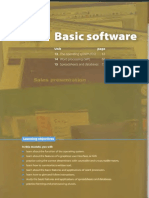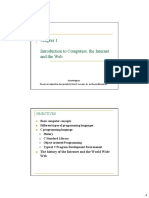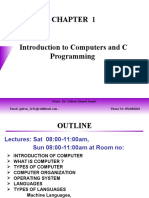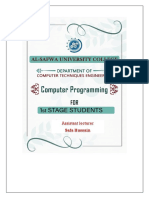0 ratings 0% found this document useful (0 votes) 18 views 9 pages All PDF Maker 20241028 10.06.45
The document discusses the evolution of user interfaces from complex command-based systems to modern graphical user interfaces (GUIs) introduced by Apple and Microsoft. It outlines various operating systems, their features, and the importance of user-friendly design for accessibility. Additionally, it covers programming languages, their classifications, and the distinction between high-level and low-level languages.
Copyright
© © All Rights Reserved
We take content rights seriously. If you suspect this is your content,
claim it here .
Available Formats
Download as PDF or read online on Scribd
Go to previous items Go to next items
Save All PDF Maker 20241028 10.06.45 For Later ieee
‘The term user interface refers to the standard
procedures that the user follows in order to interact.
with a computer In the late 1970s and early 80s,
the way users accessed computer systems was very
complex They had to memorize and type a lot of
Commands just to see the contents of a disk, to copy
files or to respond toa single prompt. In fact, it was
only experts who used computers 50 there was no
need fora user-friendly interface.
In 1984, Apple produced the Macintosh, the frst
computer with a mouse and a graphical user
interface (GUI). Macs were designed with one clear
aim to facilitate interaction with the computer. A few
years later, Microsoft launched Windows, another
‘operating system based on graphics and intuitive
tools. Nowadays, computers are used by al kinds of
people, and asa result there is a growing emphasis
‘on accessibility and user-friendly systems.
‘AGUL makes use of a WIMP environment: windows,
Icons, menus and pointer. The background of the
screen is called the desktop, which contains labelled
pictures called leans. These icons represent files or
folders. Double-clicking a folder opens a window
which contains programs, documents, or more
nested folders. When you are in a folder, you can
launch a program or document by double-clicking
the icon, or you can drag it to another location. When,
you un a program, your PC opens a window that lets
‘you work with diferent tools. ll the programs have a
high level of consistency, with similar toolbars, menu
bars, buttons and dialog boxes. A modern 0S aso
provides access to networks and allows multitasking,
Which means you can run several programs and do
various tasks ~ atthe same time.
The most popular operating systems are:
‘= The Windows family ~ designed by Microsoft
and used on most PCs. The most recent version is
Windows Vista.
Mac OS ~ created by Apple and used on
Macintosh computers.
Unix - a multi-user system, found on mainframes
and workstations in corporate installations.
Linux — open-source software developed under
the GNU General Public License. This means
anybody can copy its source code, change it and
distribute it. [tis used in computers, appliances
~ and small devices.
Windows Mobile - used on most PDAS and
smartphones (PDAS incorporating mobile
phones)
Palm OS - used on Palm handheld devices.
RIM — used on BlackBerry communication
devices. Developed by Research In Motion.
= The Symbian OS - used by some phone makers,
including Nokia and Siemens.
‘These computer platforms differ in areas such
as device installation, network connectivity or
‘compatibility with application software.
D Translate these terms and expressions into your own language. Use a
dictionary or the Internet to help you.
1 user interface (ine 1)
procedures ine 2)
commands (line 6).
tools (line 16).
desktop (line 21)
nested folders (line 25).
launch a program fine 26)
source code (line 45)
evausun�B BBS Listen again and complete this fact file.
Home Premium isfor
advanced home computing
and (2)
The Business edition is ideal
for (3)
The Ultimate edition isthe
most complete.
offers support for the latest
technologies, from DVD
creation to
6
Windows Vista editions | Other features Internet and security ‘Windows programs
0 is | The user interface has been [Internet Explorer is more | The most popular is stil
designed for users with basic | redesigned with new icons _| reliable and secure ®
needs, such asemailand | anda new a suite that includes the
The Security Centre include
internet access @ sours es lig)
an(6)
program called Windows
Defender, and a firewall that
protects your computer from
a
Word; an email program; the
Excel spreadsheet program;
and the
(10)
program, PowerPoint.
ror
4 Language work: countable and uncountable nouns
‘A Look at the HELP box and decide if these nouns from the fact file in 3B are
countable, uncountable or either, depending on the context. Write C, U, or Cand U.
user email, computing
edition entertainment interface
icon technology security spyware
Countable and uncountable nouns
Countable nouns are people or things that we can
count. They have a singular and a plural form (e.. fle,
program, system, application),
Uncountable nouns are things that we can't count.
They have no plural form (eg, software, music,
robotics, multimedia, networking, storage),
Alot of software these days is open-source,
Not: A lot of softwares these days are open-source:
Some words are countable in many languages but
uncountable in English, and are used with a singular
vetb (@.9. advice, damage, equipment, furniture,
research, news, progress, homework),
The advice he gave me was very useful
Countable nouns must havea determiner (a, the,
my, this, etc) in the singular, athough this is not
necessary in the plural
‘deleted the fle yesterday
‘ost more than 300 files when my computer crashed.
We use a before a consonant sound and an before a
‘vowel. The definite article the means you know which
‘one/ones mean,
An icon isa small graphic.
The icons on the toolbar are used to
@ We don't use a/an with uncountable nouns.
Not: aroboties
We don't use the in generalizations with uncountable
nouns or plural countable nouns.
ike music.
Not: ke the music,
Computer programs are expensive
Not: Fhe computer programs are expensive.
Countable and uncountable nouns take different
determiners.
Many, few, a few only go with countable nouns.
There are many versions of Windows Vista.
‘Much little, a little, a great deal of only go with
uncountable nouns,
have a little time free this afternoon if you want to
meet.�nit24 Program design and
computer languages
1 Programming o 3 a age
main
AE) in pairs, discuss what you think programming is.
B Look at the definition of programming in the Past good momiaaly),
Glossary. Is it similar to yours? }
2 Steps in programming
‘A Match the words (1-5) with the definitions (a-e).
1 flowchart
2. source code
3 compiler
4 machine code
5 debugging
a Program instructions written in a particular computer language
b The techniques of detecting and correcting errors (or bugs) which may occur in programs
¢ Adiagram representing the successive logical steps of the program
d_Aspecial program which converts the source program into machine code ~ the only language
understood by the processor
@ The basic instructions understood by computers; it consists of 1s and Os (binary code)
B BBS Listen to Andrea Finch, a software developer, talking to a group of
students on a training course about how a program is written and check your
answers to A.
C BBS histen again and put these steps into the correct order.
Write instructions ina programming language
Prepare documentation
Understand the problem and pian a solution
Compile the program (to turn it into machine code)
Test and debug the program
Listen again and make detailed notes. In pairs, use your notes to write a
o
a
oO
C1 Make a flowchart of the program
oO
o
D
short explanation of what each step in C means.�3 > Computer languages
A Read the text. How many high-level computer languages are mentioned?
Computer languages
Unfortunately for us, computers can't understand spoken
English or any other natural language. The only language
they can understand directly is machine code, which
consists of 1s and 0s (binary code).
Machine code is too difficult to write. For this
reason, we use symbolic languages to communicate
instructions to the computer. For example, assembly
languages use abbreviations such as ADD, SUB,
MPY to represent instructions. The program is then
translated into machine code by a piece of software
called an assembler. Machine code and assembly
languages are called low-level languages because
they are closer to the hardware. They are quite complex
and restricted to particular machines. To make the
programs easier to write, and to overcome the problem
of intercommunication between different types of
computer, software developers designed high-level
languages, which are closer to the English language.
Here are some examples:
= FORTRAN was developed by IBM in 1954 and is still
used for scientific and engineering applications.
= COBOL (Common Business Oriented Language)
was developed in 1959 and is mainly used for business
applications
= BASIC was developed in the 1960s and was widely
used in microcomputer programming because it was
easy to learn. Visual BASIC is a modern version of the
old BASIC language, used to build graphical elements
such as buttons and windows in Windows programs.
= PASCAL was created in 1971. Itis used in universities
to teach the fundamentals of programming
= Cwas developed in the 1980s at AT&T. It is used
to write system software, graphics and commercial
applications. C+ is a version of C which incorporates
object-oriented programming; the programmer
concentrates on particular things (@ piece of text, a
graphic or a table, etc) and gives each object functions
which can be altered without changing the entire
program. For example, to add a new graphics format, the
programmer needs to rework just the graphics object.
This makes programs easier to modify.
t= Java was designed by Sun in 1995 to run on the Web.
Java applets provide animation and interactive features
‘on web pages. (See Unit 25)
Programs written in high-level languages must be
translated into machine code by @ compiler or an
interpreter. A compiler translates the source code into
object code - that is, it converts the entire program
into machine code in one go. On the other hand, an
interpreter translates the source code line by line as the
program is running,
Machine code (binary)
itis important not to confuse programming languages
with markup languages, used to create web
documents, Markup languages use instructions, known
as markup tags, to format and link text files. Some
examples include:
= HTML, which allows us to describe how information
willbe displayed on web pages.
= XML, which stands for Extensible Markup Language.
While HTML uses pre-defined tags, XML enables us to
define our own tags; itis not limited by a fixed set of
tags.
= VoiceXML, which makes Web content accessible
Via voice and phone. VoiceXML is used to create voice
applications that run on the phone, whereas HTML is
used to create visual applications (for example, web
pages)
< name> Andrea Finch
<< homework Write a paragraph describing
the C language
In this XML example we have created two new
tags: and �B Read the text again and answer these questions.
Do computers understand human languages? Why? / Why not?
What is the function of an assembler?
Why did software developers design high-level languages?
Which language is used to teach programming techniques?
What is the difference between a compiler and an interpreter?
Why are HTML and VoiceXML called markup languages?
aurasune
C Complete these sentences with a computer language from the text.
1 allows us to create our own tags to describe our data better, We aren't constrained
by a pre-defined set of tags the way we are with HTML.
2. IBM developed in the 1950s. It was the first high-level language in data
processing.
3 applets are small programs that run automatically on web pages and let you
watch animated characters, play games, etc.
4 is the HTML of the voice web. Instead of using a web browser and a keyboard, you
interact with a voice browser by listening to pre-recorded audio output and sending audio input
through a telephone.
5 This language is widely used in the business community, For example, the statement ADD VAT to
NET-PRICE could be used in a program.
Word building
Look at the words in the boxes. Are they nouns, verbs or adjectives? Write n, v or
adj next to each word. There may be more than one possible answer. Complete the
sentences with words from the boxes.
Program __programmers Programming _programmable __
1 is the process of writing a program using a computer language.
2 Acomputer is.a set of instructions that tells the computer how to do a specific
task.
3° Most computer make a plan of the program before they write it.
4A keyboard allows the user to configure the layout and meaning of the keys
compile. compiler____ compilation ___
5 Programs written in a high-level language require ~ that is, translation into
machine code, the language understood by the processor.
6 A source program is converted into machine code by software called a
Programmers usually their programs to generate an object program and diagnose
possible errors.
bug debug debugger debugging ___
8 Anyerror or malfunction of a computer program is known asa
9 A_____isa program used to test and ____ other programs.
10 The process of going through the code to identify the cause of errors and fixing them is called
x�Language work:
the infinitive
A Look at the HELP box and
then make sentences using these
prompts.
1 not easy / write instructions in COBOL
Its not easy to write instructions in COBOL.
2 expensive / set up a data-processing area
3 advisable / test the programs under
different conditions
4 unusual / write a program that works
correctly the first time it’s tested
5 important / use a good debugger to fix
errors
6 easy / learn Visual BASIC
B Choose the correct words (a-c)
to complete these sentences.
1 We use high-level languages
because machine code is too difficult
, understand and debug.
a read
b reading ¢€ toread
2 | went on the course
to be a better programmer.
how
a learn b tolearn ¢ fortolearn
3 Imnot interested in that
computer language.
aleam b learning ¢ toleam
4 Herefuses the project
with me,
ado bdoing ¢ todo
5 The engineers warned the employees
not the cables.
a touch b touching _€ totouch
6 They may not tothe
conference.
acome b coming ¢ tocome
7 Spyware can make your PC
a perform —b performing
8 This program is too slow
ado b todo ¢ fordoing
The infinitive
The infinitive with tois used in the following ways:
© Toexpress purpose
We use symbolic languages to communicate
instructions to the computer.
(=in order to communicate ...)
Not:... for 0 communicate
© After adjectives
BASIC was widely used in the past because it was
easy to learn,
Machine code is too difficult to write.
(= not easy enough to write)
© After certain verbs (eg. afford, demand,
plan, agree, expect, promise, appear, hope,
refuse, arrange, learn, try, decide, manage)
A lot of companies are now trying to develop
voice applications for web access.
After the object of certain verbs (e.g. advise,
encourage, allow, expect, tell, ask, invite,
want, enable, order, warn)
HTML allows us to describe how information
will be displayed on web pages.
The bare infinitive (without fo) is used in the
following ways:
© After modal verbs (e.g. can, could, may, might,
will, would, must, should)
Unfortunately, computers can’t understand
spoken English.
High-level languages must be translated into
machine code.
After the object with the verbs make and let
Programs make computers perform specific
tasks.
more slowly.
¢ toperform
the simulation.�unit25 Java
1 Java applets
A Match the examples of Java programs, known as applets, (a-e) with the
descriptions (1-5).
1 This Land Rove
2 The Pythagoras theorem applet gives the proof of the Pythagorean theorem without wi
allows you to manipulate triangles and go through the steps of the geon
applet allows you to change the look of the vehicle,
cds. tt
etrical proof
3. The Jman for Java applet permits medical researchers to view sequential MRI (Magnetic
Resonance Images) of the brain
4 Ananalogue clock applet displays the time according to the web user's computer and lets you
set the colours and style of the hands and numbers.
5 Abanner applet displays graphic images on websites in order to advertise products or services
B Match the terms (1-5) with the definitions (a-e).
1 Java
2 applet
3. plugin
4. platforn-independent
5 object-oriented programming
an auxiliary program that enables web browsers to support ——
new content, for example animation a
software that can run on any operating system —
© anisland in Indonesia, coffee (in American slang), and a —__
programming language for internet applications
da computer programming technique that allows the creation ™
foundation of others; used to create graphical user interfaces
@ a small Java application, usually designed to run automatically
within a web page The Java logo
spd�2 TheJava language
A These statements about Java are all false. Read the text and correct them.
1 Java was invented by Microsoft
Java has no competitors.
Flash files are called animations.
2
3
4
5
6
SUPER Ure l el
Java is a programming language developed by Sun
Microsystems, specially designed to run on the Web.
Java programs (called applets) let you watch animated
characters and moving text, play music, and interact
with information on the screen (for example, control
animations and select options).
Characteristics of the Java language
Java is an object-oriented language, similar to C++,
but more dynamic and simplified to eliminate possible
programming errors. A Java program is both compiled
and interpreted (see Unit 24). First, the source code (a file
with a Java extension) is compiled and converted into
2 format called bytecode (a file with a .class extension),
which can then be executed by a Java interpreter (see
Fig, 1). Compiled Java code can run on most computers,
because there are Java interpreters, known as Java
Virtual Machines, for most operating systems.
Java is multi-threaded, meaning a Java program can
have multiple threads (parts) - that is, many different
things processing independently and continuously. This
enables the program to make the best use of available
CPU power.
With the interpreter, a program is first converted into Java bytecodes.
Java is not compatible with most computing platforms.
The Java language is single-threaded, one part executing ata time.
Why is Java popular?
Most programmers like Java because it allows them to
write applets which make web pages more interactive
and attractive. They can create graphical objects (for
example, bar charts and diagrams) and new controls (for
‘example, check boxes and push buttons with special
properties). A web page that uses Java can have sounds
that play in real time, music that plays in the background,
cartoon-style animations, real-time video and interactive
games.
The Java Micro Edition platform Java ME) is used
in mobile devices. It provides flexible tools to create
applications that run on mobile phones, PDAs, TV set
top boxes and printers. Nowadays, most phones are
configured to use Java games.
Alternatives to Java
One alternative to Java is Microsoft's C&, pronounced
‘Csharp, a .NET language based on C++ with elements
from Visual Basic and Java. There are no substantial
differences between Ci and Java, When software
developers do measurements on pieces of code,
sometimes Java is faster, sometimes Cé is.
Another competitor is Adobe Flash technology,
which supports graphics, a scripting language called
‘ActionScript, and the streaming of audio and video.
Flash is used to create animation and advertisements,
10 integrate video into web pages, and to develop
rich internet applications such as portals. Flash files,
traditionally called flash movies, have a swf fle
extension. They may be an object on a web page or be
played in the stand-alone Flash Player.�HELP box
B Match the words (1-6) with the words (a-f) to make technical terms from the
text.
1 Java 4 web @ applet system
2. operating 5 source b page e object
3. programming 6 graphical € code f language
C Complete the sentences with words from the box.
interpreted animated configured used pronounced object-oriented compiled
1 Javalets you watch characters on web pages.
2 Javaisan language, similar to C++ but more dynamic.
3. First, the source code of a Java program is into an intermediate format called
bytecode. This is then by any system possessing a Java interpreter.
4. The Java ME platform is widely in mobile devices.
Nowadays, most mobile phones are to use Java games,
6 Microsoft's Ck is a simplified version of C and C++ for the Web. It's ‘C sharp!
Language work: the -ed form
A Look at the HELP box and then put these verbs into the correct column.
stopped asked AL fol hd)
described decided
produced called
watched executed
published object-oriented
Programmed persuaded
configured converted
arranged designed

























































